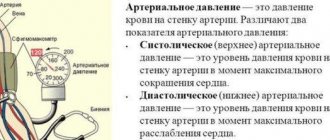As the disease develops, the doctor recommends blood and urine tests. The procedure is necessary to identify indicators that signal the presence or absence of a pathological process in the human body. The main components of lymph are red blood cells, which perform respiratory, protective and nutritional functions in the internal organ system. To identify the condition of the patient’s body based on these substances, a laboratory examination is performed - erythrocyte sedimentation rate - ESR.
When the analysis shows a high ESR in the blood, it is necessary to understand the reasons for the increase in this indicator and methods for reducing the level of red blood cells in the systemic circulation.
What is ESR
A high ESR indicates the formation of an inflammatory process
Erythrocytes are red blood cells located in the lymph. During the analysis, when anticoagulants influence the collected lymph during analysis in humans, sedimentation of these bodies occurs. The procedure calculates the time during which all red blood cells settle to the bottom of a capillary or medical tube.
The time during which the subsidence occurred is determined by the height of the plasma layer obtained after the analysis. The indicator is revealed in the ratio of millimeters to 1 hour.
ESR is a nonspecific analysis, but at the same time it has increased sensitivity. If the rate of particle sedimentation increases, this indicates the formation of a pathological process of various etiologies inside the patient’s body.
A distinctive feature of laboratory analysis is that the procedure tends to detect elevated levels even before the development of characteristic signs of the disease.
When conducting a laboratory analysis of ESR, it is possible to identify the following situations occurring in the body:
- Accurately determine the patient’s diagnosis: the presence of a heart attack, appendicitis in the acute phase of inflammation, symptoms of osteoarthritis, symptoms of a developing ectopic pregnancy.
- The patient's body's response to the therapeutic effect.
- Identify hidden diseases occurring in internal organs.
If the general blood test is normal, then the procedure for identifying red blood cells is always carried out additionally. This helps to identify not only various inflammatory processes, but also to diagnose the formation of cancer mutation cells.
Grodno Regional Children's Clinical Hospital
Details Published May 31, 2016
Head of KDL Rachkovskaya I.E.
Age-related features of a general blood test in children
A general blood test is considered one of the most accessible, simple and informative research methods that are used in children of any age, starting from the moment of birth.
Throughout the entire period of childhood, regular age-related features are revealed in the blood system. There is a characteristic dynamics of changes in hemoglobin, red blood cells, leukocytes and other hematological parameters in the first days, months and years after birth. Thus, the number of red blood cells and hemoglobin content in a child at birth is greater than in an adult, which is explained by the so-called placental transfusion and hemoconcentration. The hemoglobin content at birth in full-term infants is 180-217 g/l, in premature infants it is 145-225 g/l. Red blood cells at birth are 4.5-7.8x1012/l.
During the first week of life, hemoglobin levels begin to decline. Its minimum level is observed at 2-6 months of age and during this period is 100-130 g/l. Similar dynamics are observed on the part of red blood cells, the number of which by the end of the first half of the year reaches 3.1-4.6x1012/l. This decrease in hemoglobin concentration and the number of red blood cells is the result of increased hemolysis of fetal red blood cells (life expectancy of red blood cells in a newborn is 60-70 days) and a low level of production of red blood cells by the hematopoietic organs. The latter is due to the low production of erythropoietin, a factor that stimulates the differentiation of erythroid cells during the transition from relative intrauterine hypoxia of the fetus during placental circulation to arterialization of blood in the lungs, when blood oxygen saturation increases sharply (from 45% in utero to 95% after birth). Newborns in the first week of life are characterized by: red blood cells of large volumes (macrocytosis). In a general blood test, this indicator is designated as MCV, red blood cells with increased thickness (hyperchromia) MCH, and reticulocytosis (3-50%); which by 7-8 days of life decrease significantly. Macrocytosis and hyperchromia, characteristic of the first days of life, subsequently disappear, and at the age of 2 months to 2 years, MCV and MSI indicators are lower than the corresponding indicators for adults. MCV is 70-85 at this age, and MCH is 26-30. By 5 years, MCV and MSI levels are the same as in adults. The number of leukocytes at birth fluctuates between 8.5 and 25x109/l, then quickly falls, and by the 15th day it is 9-14x109/l. Subsequently, the number of leukocytes gradually decreases and by the age of 5 reaches the level of an adult. The number of neutrophils during the first days of life prevails over the number of lymphocytes. During the first 3 days, young cells may be found in the blood count. Subsequently, the number of neutrophils begins to decrease, while the number of lymphocytes increases. By day 5-6, the percentage of neutrophils and lymphocytes is equalized and amounts to 45% each. This is regarded as the “first cross” in the leukocyte formula in children. By three months of life, the number of neutrophils decreases to 16-46%, and lymphocytes increases to 42-74%. At the age of 4-5 years, children experience lymphocytosis due to the formation of their immune system. Then the number of neutrophils begins to increase and the number of lymphocytes to decrease, and at the age of 5-6 years a “second crossover” is observed, when the number of these cells is equalized again. By the age of 12-14 years, the leukocyte formula of children is similar to that of adults. ESR in newborns is somewhat slow: from 1.5-4 mm/h on the 1st day and up to 2.0-8.0 mm/h on the 2nd week. Over the course of 1 year of life, ESR fluctuates on average between 2-10 mm/h, and subsequently 2-12 mm/h. The number of platelets at birth is on average 180-490x109/l, then their number drops and at 1 year of life it is 150-450x109/l (as in adults). It is important to remember that changes in the blood only indicate that a certain pathological process is occurring in the body, the origin and cause of which, as a rule, is easy to understand if you compare the symptoms of the disease, their duration, the presence of similar diseases in the family, factors that could contribute to the occurrence of the disease and, if necessary, data from other research methods. The doctor, deciphering the results of a clinical blood test, carries out complex mental work, the result of which will be making a diagnosis and prescribing appropriate treatment. At the same time, it should be noted that small deviations from the norm of some indicators in a general blood test do not indicate the presence of any disease or condition; in each specific case this is decided individually after examination by a doctor.
A test that evaluates the rate of separation of blood into plasma and red blood cells. The rate of separation is mainly determined by the degree of their aggregation, i.e., the ability to stick together.
Synonyms Russian
Erythrocyte sedimentation reaction, ROE, ESR.
English synonyms
Erythrocyte sedimentation rate, Sed rate, Sedimentation rate, Westergren sedimentation rate.
Research method
Capillary photometry method.
Units
Mm/h (millimeters per hour).
What biomaterial can be used for research?
Venous, capillary blood.
How to properly prepare for research?
- Eliminate alcohol from your diet for 24 hours before the test.
- Do not eat for 2-3 hours before the test (you can drink clean still water).
- Stop taking medications 24 hours before the test (in consultation with your doctor).
- Avoid physical and emotional stress for 30 minutes before the test.
- Do not smoke for 30 minutes before the test.
General information about the study
Determination of erythrocyte sedimentation rate (ESR) is an indirect method for identifying inflammatory, autoimmune or oncological diseases. It is performed on a sample of venous or capillary blood, to which a substance has been added that allows it not to clot (anticoagulant). When analyzing ESR using the Panchenkov method, blood is placed in a thin glass or plastic tube and monitored for an hour. At this time, erythrocytes (red blood cells), as having a large specific gravity, settle, leaving a column of transparent plasma above them. The ESR is calculated based on the distance from the upper boundary of the plasma to the red blood cells. Normally, red blood cells settle slowly, leaving very little pure plasma. For this method, a Panchenkov apparatus is used, consisting of a tripod and capillary pipettes with a 100 mm scale.
For capillary photometry (automatic analyzers ROLLER, TEST1), the kinetic “stopped jet” method is used. At the beginning of the ESR analysis, programmed mixing of the sample occurs in order to disaggregate the red blood cells. Ineffective disaggregation or the presence of microclots can affect the final result, since the analyzer actually measures the kinetics of red blood cell aggregation. In this case, the measurement occurs in the range from 2 to 120 mm/h. The results of measuring ESR by this method have a high correlation with the Westergren method, which is the reference method for determining ESR in the blood, and have identical reference values.
The results obtained using the capillary photometry method in the region of normal values coincide with the results obtained when determining ESR using the Panchenkov method. However, the capillary photometry method is more sensitive to an increase in ESR, and the results in the zone of increased values are higher than the results obtained by the Panchenkov method.
An increase in the level of pathological proteins found in the liquid part of the blood, as well as some other proteins (the so-called acute-phase proteins that appear during inflammation) contributes to the “gluing” of red blood cells. Because of this, they settle faster and the ESR increases. It turns out that any acute or chronic inflammation can lead to an increase in ESR in the blood.
The fewer red blood cells, the faster they settle, which is why women have a higher ESR than men. The ESR rate varies depending on gender and age.
What is the research used for?
- For the diagnosis of diseases associated with acute or chronic inflammation, including infections, cancer and autoimmune diseases. Determining ESR is sensitive, but one of the least specific laboratory tests, since an increase in ESR in the blood itself does not allow determining the source of inflammation, in addition, it can occur not only due to inflammation. That is why analysis of ESR is usually used in combination with other studies.
When is the study scheduled?
- When conducting diagnostics and monitoring: inflammatory diseases,
- infectious diseases,
- oncological diseases,
- autoimmune diseases.
What do the results mean?
Reference values (ESR norm - table)
| Floor | Age | Reference values |
| up to 15 years | 2 - 20 mm/h | |
| Male | from 15 to 50 years | 2 – 15 mm/h |
| over 50 years old | 2 - 20 mm/h | |
| Female | up to 50 years | 2 - 20 mm/h |
| over 50 years old | 2 – 30 mm/h |
The results of this test must be interpreted in light of clinical data, medical history, and other tests.
Reasons for increased ESR in the blood
- Infectious diseases (usually bacterial causes). ESR can increase in both acute and chronic infectious diseases.
- Inflammatory diseases.
- Connective tissue diseases (rheumatoid arthritis, systemic lupus erythematosus, systemic scleroderma, vasculitis).
- Inflammatory bowel diseases (Crohn's disease, ulcerative colitis).
- Oncological diseases: Myeloma. As a rule, it is accompanied by a very high level of ESR in the blood, because with it pathological proteins are synthesized in large quantities, which cause the formation of erythrocyte “coin columns”.
- Hodgkin's disease is a malignant disease of the lymph nodes. The ESR indicator is usually used not to make a diagnosis, but to monitor the course and effectiveness of treatment of an already diagnosed disease.
- Cancer of various localizations, especially hemoblastosis. It is believed that an extremely high level of ESR in the blood indicates the spread of the tumor beyond the primary site (i.e., metastases).
- Myocardial infarction. When it occurs, damage to the heart muscle occurs, which causes a systemic inflammatory response and, accordingly, an increase in ESR. After a heart attack, the ESR peaks about a week later.
- Anemia. A decrease in the number of red blood cells can lead to an increase in their sedimentation rate.
- Burns, injuries.
- Amyloidosis is a disease associated with the accumulation of pathological protein in tissues.
Reasons for decreased ESR in the blood
- Diseases accompanied by changes in the shape of red blood cells, such as sickle cell anemia or hereditary spherocytosis (they make it difficult for red blood cells to settle).
- Polycythemia (increased number of red blood cells) and conditions that lead to it, such as, for example, chronic heart failure or lung diseases.
What can influence the result?
- ESR in women usually increases during pregnancy and menstruation.
- Oral contraceptives, theophylline, and vitamin A may increase ESR.
- Taking corticosteroids and administering albumin can reduce ESR in the blood.
Blood test for ARVI
When a child has a fever, cough and runny nose, parents want to be sure that this is a common ARVI and not a bacterial infection. Sometimes it seems to them that a general blood test will dot the i's - as soon as they take it, it will immediately become clear what the child is sick with and whether they need to give him antibiotics. However, this is not quite true. In some cases, a blood test will actually help the doctor make a diagnosis, but most often it is not necessary. In addition, the result obtained, where half of the indicators go beyond the norm, only needlessly scares parents. Pediatrician Alexandra Zhukovskaya talks about why you shouldn’t rush to get a blood test at the first symptoms of the disease.
What indicators can change during infection?
First of all, the total number of leukocytes changes - these are the cells that protect the body from viruses and bacteria. There are several types of white blood cells that perform different tasks: neutrophils, lymphocytes, monocytes, eosinophils and basophils. Their number and relationship to each other are displayed in the leukocyte formula - usually as a percentage. As soon as one indicator increases slightly, the rest will automatically decrease. This is why, with minor changes in the leukocyte formula, the forms look frighteningly red. In addition, in many laboratories, the forms indicate standards for adults, which differ from children. Thus, in children under 5 years of age, lymphocytes predominate, in older children - neutrophils, and the total number of leukocytes changes with age.
What do deviations mean?
With a bacterial infection, you usually experience:
- increase in the number of leukocytes (leukocytosis) - more than 15 × 10⁹/l;
- increase in the absolute* number of neutrophils - more than 10 × 10⁹/l;
- a shift in the leukocyte formula to the left - that is, the appearance of immature (band) forms of neutrophils - more than 1.5 × 10⁹/l.
*To estimate the absolute neutrophil count, you need to know the total white blood cell count and the percentage of neutrophils. For example: leukocytes are 9 × 10⁹/l, and neutrophils make up 72%, which is usually already highlighted in red. We count: 9 × 72/100%, we get 6.5 - that is, the normal absolute number of neutrophils.
With a viral infection, you usually experience:
- Decrease in the total number of leukocytes (leukopenia) - especially with influenza, measles, etc.
- Increased absolute number of lymphocytes (lymphocytosis).
- The appearance of “atypical” cells occurs in infectious mononucleosis.
Another nonspecific sign of inflammation is an increase in erythrocyte sedimentation rate (ESR). High ESR is typical for both viral and bacterial infections.
What then causes difficulties?
The fact is that in the first days of the disease there may not yet be any characteristic changes in the general blood test, or vice versa - the leukocytes may “jump” significantly even for a banal viral infection, casting doubt on the diagnosis. Many viruses (adenovirus, Epstein-Barr virus) lead to a persistent increase in the number of white blood cells - leukocytosis - which is usually associated with a bacterial infection.
Conversely, some bacterial diseases occur without abnormalities in blood tests - for example, otitis media or atypical pneumonia, or even with changes characteristic of a viral infection - for example, lymphocytosis is observed in whooping cough.
There are quite a few such exceptions, which is why at the beginning of the disease a general blood test cannot be a universal diagnostic method - the doctor will receive much more information during a thorough examination of the child.
How else can you clarify the diagnosis?
If the doctor suspects streptococcal sore throat or influenza, a streptate test or rapid test for influenza is performed. Methods are available to detect many viruses in saliva, nasal secretions, etc. A chest x-ray is indicated to rule out pneumonia. If a urinary tract infection is suspected, urine test strips and urine tests are performed. In case of severe intestinal infections, feces are examined for the presence of bacteria belonging to the intestinal group (salmonellosis, dysentery, etc.). If the child has been feverish for a long time and there is no obvious source of infection, the levels of C-reactive protein and procalcitonin are looked at in a biochemical blood test. Some time after the onset of the disease, specific antibodies against various infectious agents can be detected in the blood.
Isn't it easier to give an antibiotic right away?
No.
- Antibiotics are ineffective against viruses and cannot prevent bacterial complications, but vaccination against pneumococcus and other bacterial infections can cope with this.
- Antibacterial therapy disrupts the vital activity of normal microflora involved in protection against foreign and dangerous microorganisms.
- Taking antibiotics without indications leads to antibiotic resistance—bacterial resistance. This means that the next time an antibiotic is actually needed, it will no longer be harmful to the bacteria, and the disease will be more difficult to cure.
- For some viral infections (for example, infectious mononucleosis), the administration of widely used penicillin antibiotics leads to the appearance of a rash. This is often interpreted as an allergic reaction, although there are no contraindications for further use of this group of antibiotics in a child.
- All medications, including antibacterial drugs, have side effects. The benefit of any intervention should be greater than the potential harm - you should not break this rule by giving antibiotics “just in case”.
Detailed description of the study
A clinical blood test is the most important comprehensive laboratory test when examining a person with any disease. Changes in the studied parameters, as a rule, occur long before the appearance of visible symptoms of the disease.
The following indicators are determined as part of the study:
- hemoglobin concentration;
- red blood cell count;
- platelet count;
- leukocyte count;
- hematocrit;
- average red blood cell volume;
- average hemoglobin content in a red blood cell;
- average hemoglobin concentration in an erythrocyte;
- blood color index;
- absolute and percentage content of various leukocyte populations in the blood;
- erythrocyte sedimentation rate.
C-reactive protein is a protein that is detected in the blood plasma during various inflammatory processes and is a marker of the acute phase of their course.
Ig E common is used to diagnose atopic allergic diseases. The half-life of Ig E is 3 days in serum and 14 days on the membranes of mast cells and basophils. They have the ability to quickly fix on skin cells, mucous membranes, mast cells and basophils, therefore they are present in small quantities in free form. Upon repeated contact with an antigen (allergen), antibodies and antigen interact on the surface of basophils and mast cells with the release of vasoactive factors (histamine, serotonin, heparin) and the development of clinical manifestations of allergy.
Immunoglobulin E is responsible for immediate allergy, which is the most common type of allergic reaction. Immunoglobulin E also takes part in protective anthelmintic immunity. The largest amount of free antibodies in the patient’s blood appears a few days after contact with the allergen. During the acute period of the reaction, their titer is usually reduced, and when the exacerbation subsides, it increases. In 30-45% of patients with allergic diseases, the level of total Ig E does not differ from normal values. Also, the level of total immunoglobulin E can differ significantly when studied over time in the same patient, since Ig E is the shortest-lived immunoglobulin.
Glucose is one of the most important components of blood, which reflects the state of carbohydrate metabolism. The level of glucose in the blood is regulated by the central nervous system, hormonal factors, and liver function, and in a healthy person it ranges from 4.0-6.4 mmol/l.
Antistreptolysin-O (ASLO) is an antibody to the group A beta-hemolytic streptococcus antigen, streptolysin. Group A betahemolytic streptococcus (Streptococcus pyogenes) is a bacterium that causes streptococcal sore throat, scarlet fever, streptococcal pharyngitis, and skin infections.
The level of ASLO increases during the acute period of infection (7-14 days) and decreases during the period of convalescence and recovery.
University
→ Home → University → University in the media → Disease or normal? What will the ESR tell you?
A clinical blood test ranks first in the list of mandatory methods for assessing our health and is important for identifying a number of diseases. Despite the fact that the blood of a healthy person strives for constancy in its quantitative and qualitative composition, in everyday practice doctors note certain fluctuations. This also applies to the erythrocyte sedimentation rate (ESR). And although a competent interpretation of a general blood test is within the competence of a doctor, some general understanding of hematological parameters will help, if something happens, to contact a specialist in a timely manner. What is hidden behind the abbreviation “ESR” and should you worry if the result does not coincide with the norm?
The erythrocyte sedimentation rate measures how quickly the blood separates into plasma (the liquid part) and formed elements. If you add an anticoagulant (a substance that prevents clotting) to a vertically mounted test tube, the blood will gradually separate into two layers under the influence of gravity: translucent plasma will be on top, and settled red blood cells will be at the bottom. Thus, ESR is estimated by the height (in millimeters) of the top layer formed within one hour. The normal value of this indicator depends on age, gender and certain physiological conditions of the body (for example, pregnancy, menstruation). In an adult, ESR can fluctuate within a fairly wide range: 0 - 15 mm/h in men and 0 - 20 mm/h in women, which is associated with gender and other differences in the chemical composition of the blood and its level of viscosity. During pregnancy (starting from the 5th week) and in the postpartum period, ESR values increase to 20 - 25 mm/h, and in older people they can reach 30 mm/h and higher. In some cases, an increase in ESR above normal is associated with the presence of bad habits (smoking, addiction to alcohol), the nature of the diet (low-calorie
diet or, conversely, overeating), individual characteristics of the body. Let's say, according to some data, almost 5% of the planet's population has an accelerated erythrocyte sedimentation reaction from birth, but there are no obvious pathological reasons for this. Therefore, if you receive an analysis result with an elevated ESR level, you should first exclude the influence of the factors listed above. Otherwise, too rapid precipitation of red blood cells is a sign of the development of one or even several inflammatory (including infectious) diseases: viral hepatitis, influenza, pneumonia, pyelonephritis, rheumatism, arthritis, etc. After all, inflammatory processes in the human body lead to the accumulation of special protein molecules in the blood that accelerate the reaction of red blood cell adhesion. Other causes of high ESR may include previous trauma or surgery, anemia, pathology of the kidneys or thyroid gland, malignant tumors, or taking certain medications (estrogens, oral contraceptives). A reduced (close to zero) level of ESR is relatively rare and is caused primarily by chronic heart and liver diseases, excess production of red blood cells, treatment with aspirin, prednisolone, etc. In order for the results of the analysis (especially the detailed one) to be reliable, it is advisable to donate blood for research on an empty stomach or at least no earlier than 4 hours after a meal, excluding increased physical activity the day before, stress and anxiety, as well as alcohol consumption. And remember: it is impossible to make a correct diagnosis based only on the ESR indicator - this requires the participation of a specialist doctor and, as a rule, a more in-depth examination. Vladimir KHRYSCHANOVYCH , Doctor of Medical Sciences
Soviet Belarus , November 22, 2018
Share
When do you need to take the Children's Complex test?
- Diagnosis and differential diagnosis of anemia.
- Diagnosis and differential diagnosis of inflammatory diseases of infectious and non-infectious origin.
- Diagnosis and differential diagnosis of diseases of the blood system.
- Evaluation of treatment effectiveness.
- Diagnosis of complications of streptococcal infection: post-streptococcal glomerulonephritis, infectious-allergic myocarditis, rheumatism, synovitis;
- Detection of a focus of streptococcal infection in the body (a 2-fold increase in ASLO over time with an interval of 1 week has a diagnostic value);
- Monitoring for recurrent streptococcal infections.








